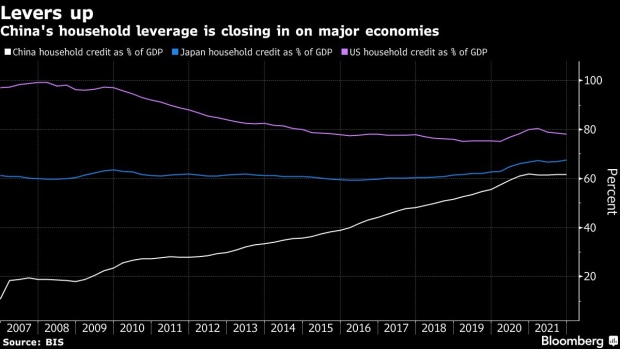Jul 26, 2022
Singapore Wealth Fund Spots Rental Opportunity in China Property
, Bloomberg News

(Bloomberg) -- Singapore’s $799 billion sovereign wealth fund sees pockets of opportunity in the beleaguered China real estate market as Beijing tries to make homes more accessible for the middle class.
In China, where disposable income per capita is a fraction of that in the US, it often takes years of savings to afford an apartment, which normally costs a few million yuan in the main urban centers. Helping middle- and lower-income Chinese is a priority for the government, said Jeffrey Jaensubhakij, chief investment officer of GIC Pte.
“For us in China, that’s one of the areas of focus,” Jaensubhakij said in an interview discussing the fund’s annual report released Wednesday. “Housing for the middle class and lower middle class is still a heightened need so, from the real estate point of view, we have partnered with a couple of companies in residential-for-rent in China.”
Policy makers have avoided piling stimulus into housing despite a sharp drop in home sales and property investment. The banking regulators reiterated last week that housing was “not for speculation,” a slogan associated with the financial tightening that’s roiled the sector and prompted dozens of developers to default.
Instead the housing ministry plans to build 2.4 million units of affordable rental housing this year, and policy makers have eased a cap on loans to fund projects in that space. The China Securities Journal has flagged rule changes that would encourage greater investment in rental projects by widening the listing rules for infrastructure real estate investment trusts or REITs.
While it’s been a tough year, “there’s a fair amount of resilience that we’ve seen in a range of real estate sectors,” Jaensubhakij said, pointing to transactions in retail properties, and continued demand for office space in Beijing and Shanghai. GIC’s greater exposure to direct holdings and projects, rather than developers’ stocks, has helped it skirt some of the turmoil, though GIC remains one of the largest non-govt shareholders of residential developer China Vanke Co., according to a June filing.
“We’ve found that the investments can still be good holdings,” he said.
Overall, GIC is looking to rotate its China exposure into areas that align with the government’s priorities including growing domestic consumption, technological self-reliance and sustainability, he said.
GIC has been an investor in Chinese technology platforms and education companies. It’s backed Ant Group Co., whose record initial public offering was torpedoed by regulators in 2020.
“We are not targeting net dis-investing in China” when it comes to exposure to the private market, said Jaensubhakij. “We are finding that there is a lot of need and a lot of room for rotation.”
Eventually GIC’s strategy depends on China’s gross domestic product, making the whole macro-economic outlook important, said Chief Executive Officer Lim Chow Kiat. “We maintain our presence in China,” he said. “Whether we net invest or not depends on whether we can find those opportunities.”
The fund expects GDP growth probably bottomed in the second quarter, with a front loading of fiscal stimulus likely to support economic activity going forward, according to Chief Economist Prakash Kannan.
GIC, which does not provide its assets under management, is believed to hold assets worth $799 billion, according to consulting and research firm Global SWF. But estimates vary; competing firm SWFI pegs the firm’s assets at a more conservative $690 billion.
©2022 Bloomberg L.P.






